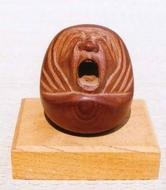:::::::::::::::::::::::::::::::::::::::::::::::::::::::::::::::::::::::::::::::::::::::::::::::::::::
Fudo Myo-O Gallery
:::::::::::::::::::::::::::::::::::::::::::::::::::::::::::::::::::::::::::::::::::::::::::::::::::::
Fudoo shinkoo 不動信仰 Fudo Shinko
Believing in Fudo Myo-O

Hisao Tanaka 田中久夫
Fudo shinko 不動信仰
ISBN-10: (4-639-01182-2 / 4639011822)
Contents
Chapter - Author - Pages
不動信仰 - 有賀祥隆 著 5−29
不動尊信仰の伝播者の問題 - 田中久夫 著 31−46
- peopole propagating the belief
修験道と不動明王 宮家準 著 47−55 - Shugendo
葛川明王院と地主神社 景山春樹 著 59−81 Kuzugawa and local deities
院政期における秘密修法 速水侑 著 83−107
- time of rule by a retired emperors
平安朝における憑霊現象 - 酒向伸行 著 109−122
Heian period
平安朝の憑祈禱 - 酒向伸行 著 123−136
- Yorigito - mediumistic healing rites
修験道の理念と説法 - 和歌森太郎 著 139−153 Shugendo
相応と回峯行 - 村山修一 著 155−166 - Kaiho-gyo
観音信仰と播磨の法道仙人 - 田中久夫 著 167−191- Kannon
厄年と除厄法- 藤江寿美恵 著 193−227 yakudoshi, yakuyoke
長宝寺「よみがえりの草子」の不動明王信仰について
yomigaeri - 井阪康二 著 229−249
成田山縁起とその草創期 - 村上重良 著 253−255 Naritasan
成田不動講 - 村上重良 著 257−265
明治維新と原口照輪 村上重良 著 267−273 Meiji time
不動信仰の都市的性格 - 市川秀之 著 275−304
- Osaka Takidani Fudo
六郷山の権現信仰と修験 - 大嶽順公 著 307−311
六郷山の信仰体 - 大嶽順公 著 313−317
倶利迦羅不動について - 中村慶太 著 319−339 Kurikara
五方に勧請される仏神の変貌 - 岩田勝 著 341−348 Goho
不動尊信仰の研究成果と課題 - 田中久夫 著 349−360
:::::::::::::::::::::::::::::::::::::::::::::::::::::::::::::::::::::::::::::::::::::::::::::::::::::
yorigitoo 憑祈祷 / 憑り祈祷 exorcistic 祈祷 kito rituals
- quote
The act of communicating or channeling spirits in special rituals. These rites usually involve both a shaman, or spirit medium, and a holy person or someone pure in spirit. While their origins are not clear, scholars believe the rites may have come to Japan from China through early Buddhism. They were practiced in Japan from ancient times but were officially discouraged by the government at the end of the 19th century.
The best-known ritual, dating from the ninth century and traced to China, was called the Abisha-ho. Four boys or girls around eight years old, all with markless bodies, prepared themselves for a week. The children kept their bodies pure by eating carefully chosen foods. After a special bath, the children put camphor (a kind of wood) in their mouths and then stood on an altar. Attendants prayed a special mantra and burned incense. The boys or girls could then be asked questions about the future or other things and were believed to respond with the truth. This rite was practiced by both the Shingon and Tendai sects of Buddhism, and there are accounts of emperors using it to answer questions about their reign.
- source : www.fofweb.com
- quote
Sacred Places of Japan:
The syncretistic Shinto-Buddhist sects gather at Mount Yamabushi, where a mountain ascetic tradition flourishes. At Mount Ontake, a favorite place for yo or pilgrim clubs to gather, mediums assemble and perform the yorigito ritual to enable them to predict the future and manifest other psychic powers. Farther north, the Ainu of Hokkaido represent the people of Japan with a core shamanic religion closest to Indians of North America, however according to Hitoshi Watanabe (1972), "there are no longer living Ainu who have (fully) personally experienced traditional Ainu life."
- snip -
To the south of Sendai, high in the interior mountains, is another spectacular sei-chi, Akyuotaki Park which protects and honors a spectacular waterfall. Visitors to the park may walk down a simple gravel path to see the cascading water, as in a park in place in the world, or they may take the path that leads to the Shinto shrine which honors the god, Fudo, said to be the shaman's god, the god of fire, who stands for truth and justice. Taking this second path the visitor is transformed from a tourist to a pilgrim.
- source : www.jamesswan.com -James A. Swan
- quote
Ontake Shinkō
In addition, sacred mountains connected with the Ontake cult, such as Hakkai, Hotaka and Ryōgami, developed locally over an area from northern Kantō to Niigata. The reason for the expansion of the influence of the confraternities was due to shamanic practices called oza, which were yorigito rituals similar to those performed by shugenja to call the kami into the body of a medium, and propagation activities that promised that the soul of the believer would be drawn to Ontake after death.
- source : Nakayama Hajime Kokugakuin 2007
.......................................................................
- quote
Fudo Myoo: A Japanese Siva Reflection
GLIMPSES INTO JAPAN'S SHAMAN PATH AND THE KUNDALINI DEITY FUDO MYOO
Overwhelmingly a one nerve current cavernously flows beneath the Orient landmass, welling up at different points and periods as yogis - Indian, Chinese, Japanese - plumbed the uniquely Asian akasha of consciousness. Cruder overland intercourse and dispersion of ideas by trade and travel mirrored the subtler mind routes. Today religious similarities, sympathies and sensibilities wed snow-capped Fuji to icy Kailas in an unearthly way.
Examples abound. Esoteric Tendai Buddhists believe Maheshwara (Siva) taught them Yorigito, mediumship and at the secluded mountainside temple of Ryosanji, in Okayama, an ichiko, priest, wears large white swastikas, the ancient Hindu symbol, embroidered on front and back of his indigo gown.
- source : www.hinduismtoday.com
- yorigito - reference -
:::::::::::::::::::::::::::::::::::::::::::::::::::::::::::::::::::::::::::::::::::::::::::::::::::::
. Fudō Myō-ō, Fudoo Myoo-Oo 不動明王 Fudo Myo-O
Acala Vidyârâja - Vidyaraja - Fudo Myoo .
:::::::::::::::::::::::::::::::::::::::::::::::::::::::::::::::::::::::::::::::::::::::::::::::::::::






2 comments:
Aichi 愛知県
岩崎御嶽社 Shrine Iwasaki Ontakesha
愛知県日進市岩崎町竹ノ山138番地
Takenoyama-138 Iwasakichō, Nisshin-shi, Aichi
In 1860, two mountain priests, 明心 Myoshin and 明寛 Myokan had an inspiration from 御嶽大神 the Great Deity of Mount Ontake in Kiso to built it here. On the left side of the shrine is 洞穴 a cave with a statue of Fudo Myo-0, called
O-tasuke ana Fudo お助け穴不動
Fudo in the cave to help people
.
anafudoo 穴不動 Ana Fudo in a Cave
https://fudosama.blogspot.jp/2017/07/ana-fudo-in-cave.html
.
kitooshi, kitōshi 祈祷師と伝説 Kitoshi, Legends about Shamans
.
https://heianperiodjapan.blogspot.com/2018/10/kitoshi-shaman-legends.html
.
Post a Comment